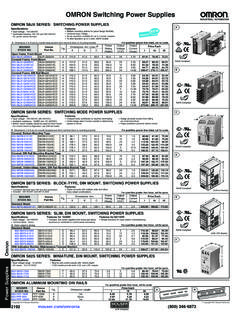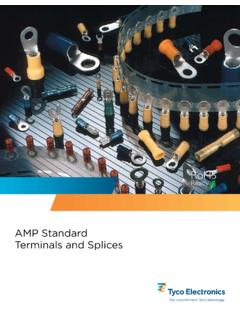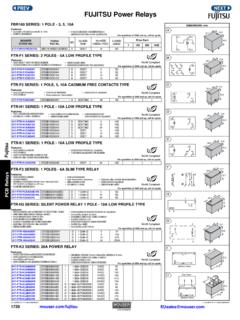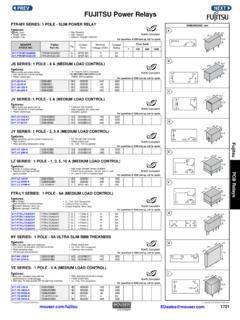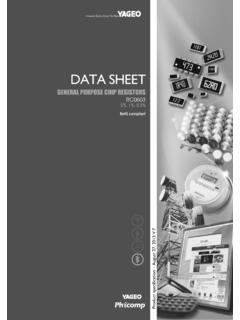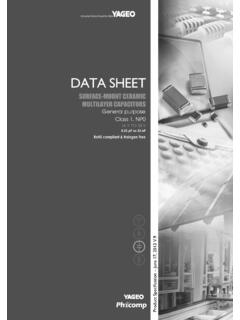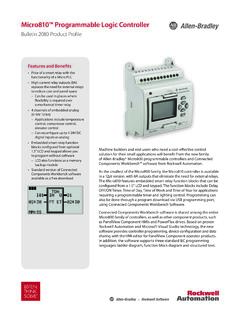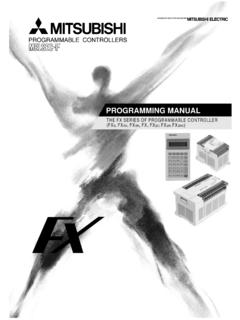Transcription of Microcontroller with 4/8/16/32K Bytes In-System ...
1 Features High Performance, Low Power AVR 8-Bit Microcontroller Advanced RISC Architecture 131 Powerful Instructions Most Single Clock Cycle Execution 32 x 8 General Purpose Working Registers Fully Static Operation Up to 20 MIPS Throughput at 20 MHz On-chip 2-cycle Multiplier High Endurance Non-volatile Memory Segments 4/8/16/32K Bytes of In-System Self- programmable Flash progam memory (ATmega48PA/88PA/168PA/328P) 256/512/512/1K Bytes EEPROM (ATmega48PA/88PA/168PA/328P) 512/1K/1K/2K Bytes Internal SRAM (ATmega48PA/88PA/168PA/328P) Write/Erase Cycles: 10,000 Flash/100,000 EEPROM Data retention: 20 years at 85 C/100 years at 25 C(1) Optional Boot Code Section with Independent Lock BitsIn-System Programming by On-chip Boot ProgramTrue Read-While-Write Operation Programming Lock for Software Security Peripheral Features Two 8-bit timer /Counters with Separate Prescaler and Compare Mode One 16-bit timer /Counter with Separate Prescaler, Compare Mode, and Capture Mode Real Time Counter with Separate Oscillator Six PWM Channels 8-channel 10-bit ADC in TQFP and QFN/MLF packageTemperature Measurement 6-channel 10-bit ADC in PDIP PackageTemperature Measurement programmable Serial USART Master/Slave SPI Serial Interface Byte-oriented 2-wire Serial Interface (Philips I2C compatible)
2 programmable Watchdog timer with Separate On-chip Oscillator On-chip Analog Comparator Interrupt and Wake-up on Pin Change Special Microcontroller Features Power-on Reset and programmable Brown-out Detection Internal Calibrated Oscillator External and Internal Interrupt Sources Six Sleep Modes: Idle, ADC Noise Reduction, Power-save, Power-down, Standby, and Extended Standby I/O and Packages 23 programmable I/O Lines 28-pin PDIP, 32-lead TQFP, 28-pad QFN/MLF and 32-pad QFN/MLF Operating Voltage: - for ATmega48PA/88PA/168PA/328P Temperature Range: -40 C to 85 C Speed Grade: 0 - 20 MHz @ - Low Power Consumption at 1 MHz, , 25 C for ATmega48PA/88PA/168PA/328P: Active Mode: mA Power-down Mode: A Power-save Mode: A (Including 32 kHz RTC)8-bit Microcontroller with 4/8/16/32K Bytes In-SystemProgrammable FlashATmega48 PAAT mega88 PAAT mega168 PAAT mega328 PSummaryRev.
3 8161CS AVR 05/0928161CS AVR 05/09 ATmega48PA/88PA/168PA/328P1. Pin ConfigurationsFigure ATmega48PA/88PA/168PA/328P12345678242322 2120191817(PCINT19/OC2B/INT1) PD3(PCINT20/XCK/T0) PD4 GNDVCCGNDVCC(PCINT6/XTAL1/TOSC1) PB6(PCINT7/XTAL2/TOSC2) PB7PC1 (ADC1/PCINT9)PC0 (ADC0/PCINT8)ADC7 GNDAREFADC6 AVCCPB5 (SCK/PCINT5)3231302928272625910111213141 516(PCINT21/OC0B/T1) PD5(PCINT22/OC0A/AIN0) PD6(PCINT23/AIN1) PD7(PCINT0/CLKO/ICP1) PB0(PCINT1/OC1A) PB1(PCINT2/SS/OC1B) PB2(PCINT3/OC2A/MOSI) PB3(PCINT4/MISO) PB4PD2 (INT0/PCINT18)PD1 (TXD/PCINT17)PD0 (RXD/PCINT16)PC6 (RESET/PCINT14)PC5 (ADC5/SCL/PCINT13)PC4 (ADC4/SDA/PCINT12)PC3 (ADC3/PCINT11)PC2 (ADC2/PCINT10)TQFP Top View123456789101112131428272625242322212 01918171615(PCINT14/RESET) PC6(PCINT16/RXD) PD0(PCINT17/TXD) PD1(PCINT18/INT0) PD2(PCINT19/OC2B/INT1) PD3(PCINT20/XCK/T0) PD4 VCCGND(PCINT6/XTAL1/TOSC1) PB6(PCINT7/XTAL2/TOSC2) PB7(PCINT21/OC0B/T1) PD5(PCINT22/OC0A/AIN0) PD6(PCINT23/AIN1) PD7(PCINT0/CLKO/ICP1) PB0PC5 (ADC5/SCL/PCINT13)
4 PC4 (ADC4/SDA/PCINT12)PC3 (ADC3/PCINT11)PC2 (ADC2/PCINT10)PC1 (ADC1/PCINT9)PC0 (ADC0/PCINT8)GNDAREFAVCCPB5 (SCK/PCINT5)PB4 (MISO/PCINT4)PB3 (MOSI/OC2A/PCINT3)PB2 (SS/OC1B/PCINT2)PB1 (OC1A/PCINT1)PDIP12345678242322212019181 7323130292827262591011121314151632 MLF Top View(PCINT19/OC2B/INT1) PD3(PCINT20/XCK/T0) PD4 GNDVCCGNDVCC(PCINT6/XTAL1/TOSC1) PB6(PCINT7/XTAL2/TOSC2) PB7PC1 (ADC1/PCINT9)PC0 (ADC0/PCINT8)ADC7 GNDAREFADC6 AVCCPB5 (SCK/PCINT5)(PCINT21/OC0B/T1) PD5(PCINT22/OC0A/AIN0) PD6(PCINT23/AIN1) PD7(PCINT0/CLKO/ICP1) PB0(PCINT1/OC1A) PB1(PCINT2/SS/OC1B) PB2(PCINT3/OC2A/MOSI) PB3(PCINT4/MISO) PB4PD2 (INT0/PCINT18)PD1 (TXD/PCINT17)PD0 (RXD/PCINT16)PC6 (RESET/PCINT14)PC5 (ADC5/SCL/PCINT13)PC4 (ADC4/SDA/PCINT12)PC3 (ADC3/PCINT11)PC2 (ADC2/PCINT10)NOTE: Bottom pad should be soldered to MLF Top View(PCINT19/OC2B/INT1) PD3(PCINT20/XCK/T0) PD4 VCCGND(PCINT6/XTAL1/TOSC1) PB6(PCINT7/XTAL2/TOSC2) PB7(PCINT21/OC0B/T1) PD5(PCINT22/OC0A/AIN0) PD6(PCINT23/AIN1) PD7(PCINT0/CLKO/ICP1) PB0(PCINT1/OC1A) PB1(PCINT2/SS/OC1B) PB2(PCINT3/OC2A/MOSI) PB3(PCINT4/MISO) PB4PD2 (INT0/PCINT18)PD1 (TXD/PCINT17)PD0 (RXD/PCINT16)PC6 (RESET/PCINT14)PC5 (ADC5/SCL/PCINT13)PC4 (ADC4/SDA/PCINT12)PC3 (ADC3/PCINT11)PC2 (ADC2/PCINT10)PC1 (ADC1/PCINT9)PC0 (ADC0/PCINT8)GNDAREFAVCCPB5 (SCK/PCINT5)NOTE: Bottom pad should be soldered to AVR 05/09 ATmega48PA/88PA/168 supply B (PB7:0) XTAL1/XTAL2/TOSC1/TOSC2 Port B is an 8-bit bi-directional I/O port with internal pull-up resistors (selected for each bit).
5 ThePort B output buffers have symmetrical drive characteristics with both high sink and sourcecapability. As inputs, Port B pins that are externally pulled low will source current if the pull-upresistors are activated. The Port B pins are tri-stated when a reset condition becomes active,even if the clock is not on the clock selection fuse settings, PB6 can be used as input to the inverting Oscil-lator amplifier and input to the internal clock operating on the clock selection fuse settings, PB7 can be used as output from the invertingOscillator the Internal Calibrated RC Oscillator is used as chip clock source, is used as for the Asynchronous timer /Counter2 if the AS2 bit in ASSR is various special features of Port B are elaborated in Alternate Functions of Port B on page76 and System Clock and Clock Options on page C (PC5:0)Port C is a 7-bit bi-directional I/O port with internal pull-up resistors (selected for each bit).
6 Output buffers have symmetrical drive characteristics with both high sink and sourcecapability. As inputs, Port C pins that are externally pulled low will source current if the pull-upresistors are activated. The Port C pins are tri-stated when a reset condition becomes active,even if the clock is not the RSTDISBL Fuse is programmed, PC6 is used as an I/O pin. Note that the electrical char-acteristics of PC6 differ from those of the other pins of Port the RSTDISBL Fuse is unprogrammed, PC6 is used as a Reset input. A low level on this pinfor longer than the minimum pulse length will generate a Reset, even if the clock is not minimum pulse length is given in Table 28-3 on page 308. Shorter pulses are not guaran-teed to generate a various special features of Port C are elaborated in Alternate Functions of Port C on D (PD7:0)Port D is an 8-bit bi-directional I/O port with internal pull-up resistors (selected for each bit).
7 ThePort D output buffers have symmetrical drive characteristics with both high sink and sourcecapability. As inputs, Port D pins that are externally pulled low will source current if the pull-upresistors are activated. The Port D pins are tri-stated when a reset condition becomes active,even if the clock is not AVR 05/09 ATmega48PA/88PA/168PA/328 PThe various special features of Port D are elaborated in Alternate Functions of Port D on is the supply voltage pin for the A/D Converter, PC3:0, and ADC7:6. It should be externallyconnected to VCC, even if the ADC is not used. If the ADC is used, it should be connected to VCCthrough a low-pass filter. Note that use digital supply voltage, is the analog reference pin for the A/D :6 (TQFP and QFN/MLF Package Only)In the TQFP and QFN/MLF package, ADC7:6 serve as analog inputs to the A/D pins are powered from the analog supply and serve as 10-bit ADC AVR 05/09 ATmega48PA/88PA/168PA/328P2.
8 OverviewThe ATmega48PA/88PA/168PA/328P is a low-power CMOS 8-bit Microcontroller based on theAVR enhanced RISC architecture. By executing powerful instructions in a single clock cycle, theATmega48PA/88PA/168PA/328P achieves throughputs approaching 1 MIPS per MHz allowingthe system designer to optimize power consumption versus processing DiagramFigure DiagramThe AVR core combines a rich instruction set with 32 general purpose working registers. All the32 registers are directly connected to the Arithmetic Logic Unit (ALU), allowing two independentregisters to be accessed in one single instruction executed in one clock cycle. The resultingPORT C (7)PORT B (8)PORT D (8)USART 08bit T/C 216bit T/C 18bit T/C 0A/D WatchdogOscillatorWatchdogTimerOscillato rCircuits /ClockGenerationPowerSupervisionPOR / BOD &RESETVCCGNDPROGRAMLOGIC debugWIRE2 GNDAREFAVCCDATA B U SADC[ ]PC[ ]PB[ ]PD[ ]6 RESETXTAL[ ]CPU68161CS AVR 05/09 ATmega48PA/88PA/168PA/328 Parchitecture is more code efficient while achieving throughputs up to ten times faster than con-ventional CISC ATmega48PA/88PA/168PA/328P provides the following features.
9 4/8/16/32K Bytes of In-System programmable Flash with Read-While-Write capabilities, 256/512/512/1K bytesEEPROM, 512/1K/1K/2K Bytes SRAM, 23 general purpose I/O lines, 32 general purpose work-ing registers, three flexible timer /Counters with compare modes, internal and externalinterrupts, a serial programmable USART, a byte-oriented 2-wire Serial Interface, an SPI serialport, a 6-channel 10-bit ADC (8 channels in TQFP and QFN/MLF packages), a programmableWatchdog timer with internal Oscillator, and five software selectable power saving modes. TheIdle mode stops the CPU while allowing the SRAM, timer /Counters, USART, 2-wire Serial Inter-face, SPI port, and interrupt system to continue functioning. The Power-down mode saves theregister contents but freezes the Oscillator, disabling all other chip functions until the next inter-rupt or hardware reset. In Power-save mode, the asynchronous timer continues to run, allowingthe user to maintain a timer base while the rest of the device is sleeping.
10 The ADC Noise Reduc-tion mode stops the CPU and all I/O modules except asynchronous timer and ADC, to minimizeswitching noise during ADC conversions. In Standby mode, the crystal/resonator Oscillator isrunning while the rest of the device is sleeping. This allows very fast start-up combined with lowpower consumption. The device is manufactured using Atmel s high density non-volatile memory technology. TheOn-chip ISP Flash allows the program memory to be reprogrammed In-System through an SPIserial interface, by a conventional non-volatile memory programmer, or by an On-chip Boot pro-gram running on the AVR core. The Boot program can use any interface to download theapplication program in the Application Flash memory. Software in the Boot Flash section willcontinue to run while the Application Flash section is updated, providing true Read-While-Writeoperation. By combining an 8-bit RISC CPU with In-System Self- programmable Flash on amonolithic chip, the Atmel ATmega48PA/88PA/168PA/328P is a powerful Microcontroller thatprovides a highly flexible and cost effective solution to many embedded control ATmega48PA/88PA/168PA/328P AVR is supported with a full suite of program and systemdevelopment tools including: C Compilers, Macro Assemblers, Program Debugger/Simulators,In-Circuit Emulators, and Evaluation Between ATmega48PA, ATmega88PA, ATmega168PA and ATmega328 PThe ATmega48PA, ATmega88PA, ATmega168PA and ATmega328P differ only in memorysizes, boot loader support, and interrupt vector sizes.
